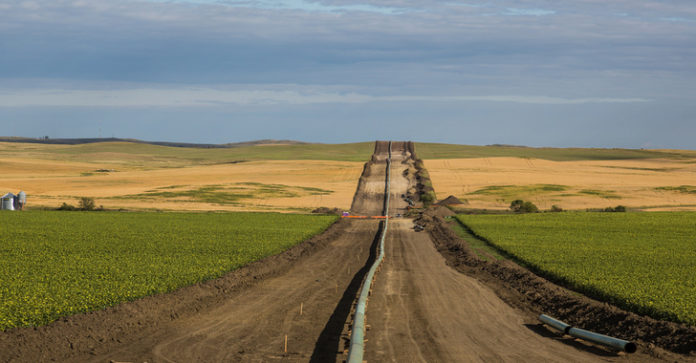
(CommonDreams) An independent pipeline expert has concluded that the U.S. Army Corps of Engineers’ environmental assessment (EA) of the Dakota Access Pipeline (DAPL) is insufficient and fails to account for the impact on tribal members, prompting the Standing Rock Sioux to demand that the federal agency “revisit” its approval of the controversial project.
The review, commissioned by the tribe, found that the Army Corps’ EA “understates the risk of pipeline failure and related oil release from this pipeline impacting Lake Oahe and the Missouri River,” determined (pdf) Richard Kuprewicz, a pipeline engineer with the consulting firm Accufacts, Inc.
Earthjustice, which is representing the Standing Rock Sioux in its litigation against the Corps, outlined additional “areas of deficiency” identified in the review:
- Shoddy pipeline construction
- The risks posed by landslides were underestimated
- Lack of proper safety constructions to contain spills
- Failure to review impact to residents and environment downstream of the site
- A risk review of industry spills and containment at similar sites that document problematic regulatory oversight of the industry in North Dakota
In a letter (pdf) sent late last week to Jo-Ellen Darcy, assistant secretary of the Army for Civil Works, Standing Rock Sioux chairman Dave Archambault II presents Kuprewicz’s findings in contrast to the EA’s determination that building a pipeline across Lake Oahe “will not affect members of the Standing Rock Sioux Tribe or the Tribal reservation.”
The review, he said, “underscores one of the fundamental deficiencies of the Final Environmental Assessment—it assumes, without foundation, that placing a massive oil pipeline just upstream from the Reservation presents no risk to the Tribe.
Alternately, “Mr. Kuprewicz’s findings reflect the common sense point that was somehow lost in the Final Environmental Analysis—that pipelines leak, and that when they do so there are often devastating consequences, particularly when the leak contaminates water,” he noted.
“This raises the question,” Archambault continued, “if the Dakota Access pipeline is so safe that it presents no risk at all when situated on the Tribe’s doorstep, why isn’t the pipeline safe enough to cross the river north of Bismarck, as originally proposed? The Final EA provides no answer.”
Earthjustice staff attorney Jan Hasselman, who represents the Tribe, said, “The law requires a full and transparent analysis of risks like oil spills prior to issuance of a federal permit. It’s clear that never happened here.”
Indeed, as recent news events have shown, and as Archambault himself pointed out in the letter, “the public record is filled with examples” of pipeline failure. The past two weeks alone have seen a deadly gasoline pipeline explosion in Alabama, and successive pipeline leaks in Oklahoma and Pennsylvania, respectively discharging crude oil and gasoline.
According to data from the Pipeline and Hazardous Materials Safety Administration, an average of over 59 oil spills occur each year while the average amount of oil spilled from pipelines topping 47,000 barrels. North Dakota alone had 1238 reported incidents of spills of oil or oilfield wastewater in the 12-month period from July 27, 2015 through July 25, 2016.
Referencing these “sobering” statistics, as well as many of the documented instances, Archambault concluded that the Army Corps should deny the easement for the Lake Oahe pipeline crossing.
This article (Demands Grow to Review DAPL Approval as Risk of Spills Was Downplayed by Gov’t) by Lauren McCauley originally appeared on CommonDreams.org and is licensed Creative Commons. Image credit: Flickr/Tony Webster.




